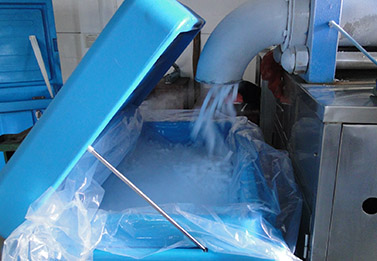A Silent Threat to Lives
The chilling story begins on the evening of June 15 in Henan Province, where a refrigerated van carrying fresh food became the scene of a silent tragedy. Eight female workers were found unconscious in the enclosed, low-temperature compartment. Authorities suspect a dry ice leak led to oxygen deprivation, causing asphyxiation and, ultimately, their untimely deaths. While investigations are ongoing, this incident underscores the underestimated dangers of dry ice in confined spaces.
What Is Dry Ice?
For most, “ice” conjures images of a refreshing summer drink. But in science, ice takes on a far more fascinating form. Dry ice, the solid form of carbon dioxide (CO₂), was first discovered in 1835 by French chemist Charles Thilorier. He observed that liquid CO₂, upon evaporation, left behind a solid residue—what we now know as dry ice.
Unlike regular ice, which melts into water, dry ice sublimates directly from a solid to a gas at -78.5°C, leaving no liquid residue. This property has made it a preferred choice for transporting perishable goods like ice cream and medical supplies.
The Perils of Dry Ice
Despite its widespread use, dry ice poses a silent danger. CO₂ is a colorless, odorless gas that is heavier than air, causing it to settle at the bottom of enclosed spaces. In poorly ventilated environments, sublimating dry ice displaces oxygen, leading to hypoxia (low oxygen levels) and an increase in CO₂ concentration.
Symptoms of CO₂ Overexposure:
- Sweating
- Rapid breathing
- Heart palpitations
- Shortness of breath
- Fainting
When CO₂ levels exceed 2%, symptoms become evident. At 5%, the gas induces a narcotic effect. Above 8–10%, unconsciousness and death can occur within minutes.
Real-Life Incidents
Tragic stories of dry ice mishandling highlight its lethal potential:
- 2004 Hurricane Ivan: A man used 45 kg of dry ice to preserve food in his car during a power outage. The vehicle’s poor ventilation caused CO₂ levels to rise, leaving him unconscious until rescued.
- 2022 Lab Accident: A graduate student at the University of California fainted while handling dry ice in a deep container. Although she recovered, the experience left her with PTSD, underscoring the emotional and physical toll of CO₂ exposure.
Why CO₂ Is Dangerous
The molecular weight of CO₂ makes it denser than air, causing it to accumulate in low-lying areas. As CO₂ concentration increases, oxygen levels drop, triggering physiological effects such as hyperventilation, reduced blood pH, and disruption of the heart and nervous system.
Prevention Measures
- Proper Ventilation: Always handle dry ice in well-ventilated areas to prevent CO₂ accumulation.
- Warning Labels: Suppliers must clearly label containers with hazard warnings to alert users of the risks.
- Consumer Awareness: Avoid storing or using dry ice in enclosed spaces, such as vehicles or small rooms.
Conclusion
Dry ice is an essential tool for food preservation and industrial processes, but its dangers in confined spaces are often overlooked. This invisible, odorless gas can turn fatal within minutes if mishandled. Raising awareness and enforcing safety measures are critical to preventing similar tragedies.
Post time: Nov-25-2024


